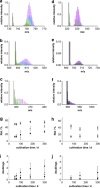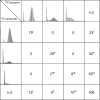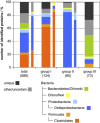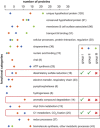Protein-SIP enables time-resolved analysis of the carbon flux in a sulfate-reducing, benzene-degrading microbial consortium
- PMID: 22791237
- PMCID: PMC3504967
- DOI: 10.1038/ismej.2012.68
Protein-SIP enables time-resolved analysis of the carbon flux in a sulfate-reducing, benzene-degrading microbial consortium
Abstract
Benzene is a major contaminant in various environments, but the mechanisms behind its biodegradation under strictly anoxic conditions are not yet entirely clear. Here we analyzed a benzene-degrading, sulfate-reducing enrichment culture originating from a benzene-contaminated aquifer by a metagenome-based functional metaproteomic approach, using protein-based stable isotope probing (protein-SIP). The time-resolved, quantitative analysis of carbon fluxes within the community supplied with either (13)C-labeled benzene or (13)C-labeled carbonate yielded different functional groups of organisms, with their peptides showing specific time dependencies of (13)C relative isotope abundance indicating different carbon utilization. Through a detailed analysis of the mass spectrometric (MS) data, it was possible to quantify the utilization of the initial carbon source and the metabolic intermediates. The functional groups were affiliated to Clostridiales, Deltaproteobacteria and Bacteroidetes/Chlorobi. The Clostridiales-related organisms were involved in benzene degradation, putatively by fermentation, and additionally used significant amounts of carbonate as a carbon source. The other groups of organisms were found to perform diverse functions, with Deltaproteobacteria degrading fermentation products and Bacteroidetes/Chlorobi being putative scavengers feeding on dead cells. A functional classification of identified proteins supported this allocation and gave further insights into the metabolic pathways and the interactions between the community members. This example shows how protein-SIP can be applied to obtain temporal and phylogenetic information about functional interdependencies within microbial communities.
Figures





Similar articles
-
Pulsed (13)C2-Acetate Protein-SIP Unveils Epsilonproteobacteria as Dominant Acetate Utilizers in a Sulfate-Reducing Microbial Community Mineralizing Benzene.Microb Ecol. 2016 May;71(4):901-11. doi: 10.1007/s00248-016-0731-y. Epub 2016 Feb 4. Microb Ecol. 2016. PMID: 26846217
-
Anaerobic Benzene Mineralization by Nitrate-Reducing and Sulfate-Reducing Microbial Consortia Enriched From the Same Site: Comparison of Community Composition and Degradation Characteristics.Microb Ecol. 2018 May;75(4):941-953. doi: 10.1007/s00248-017-1100-1. Epub 2017 Nov 9. Microb Ecol. 2018. PMID: 29124312
-
Benzene Degradation by a Variovorax Species within a Coal Tar-Contaminated Groundwater Microbial Community.Appl Environ Microbiol. 2017 Feb 1;83(4):e02658-16. doi: 10.1128/AEM.02658-16. Print 2017 Feb 15. Appl Environ Microbiol. 2017. PMID: 27913419 Free PMC article.
-
The use of nucleic acid based stable isotope probing to identify the microorganisms responsible for anaerobic benzene and toluene biodegradation.J Microbiol Methods. 2011 May;85(2):83-91. doi: 10.1016/j.mimet.2011.02.011. Epub 2011 Feb 26. J Microbiol Methods. 2011. PMID: 21356251 Review.
-
Protein-based stable isotope probing (protein-SIP) in functional metaproteomics.Mass Spectrom Rev. 2012 Nov-Dec;31(6):683-97. doi: 10.1002/mas.21346. Epub 2012 Mar 15. Mass Spectrom Rev. 2012. PMID: 22422553 Review.
Cited by
-
Transient Oxygen Exposure Causes Profound and Lasting Changes to a Benzene-Degrading Methanogenic Community.Environ Sci Technol. 2022 Sep 20;56(18):13036-13045. doi: 10.1021/acs.est.2c02624. Epub 2022 Sep 9. Environ Sci Technol. 2022. PMID: 36083837 Free PMC article.
-
Microbial Diversity Under the Influence of Natural Gas Storage in a Deep Aquifer.Front Microbiol. 2021 Oct 13;12:688929. doi: 10.3389/fmicb.2021.688929. eCollection 2021. Front Microbiol. 2021. PMID: 34721313 Free PMC article.
-
Fermentative Spirochaetes mediate necromass recycling in anoxic hydrocarbon-contaminated habitats.ISME J. 2018 Aug;12(8):2039-2050. doi: 10.1038/s41396-018-0148-3. Epub 2018 May 30. ISME J. 2018. PMID: 29849169 Free PMC article.
-
GroEL-Proteotyping of Bacterial Communities Using Tandem Mass Spectrometry.Int J Mol Sci. 2023 Oct 28;24(21):15692. doi: 10.3390/ijms242115692. Int J Mol Sci. 2023. PMID: 37958676 Free PMC article.
-
Phylogenetic and functional diversity within toluene-degrading, sulphate-reducing consortia enriched from a contaminated aquifer.Microb Ecol. 2014 Aug;68(2):222-34. doi: 10.1007/s00248-014-0403-8. Epub 2014 Mar 13. Microb Ecol. 2014. PMID: 24623528
References
-
- Bastida F, Rosell M, Franchini AG, Seifert J, Finsterbusch S, Jehmlich N, et al. Elucidating MTBE degradation in a mixed consortium using a multidisciplinary approach. FEMS Microbiol Ecol. 2010;73:370–384. - PubMed
-
- Boschker HTS, Nold SC, Wellsbury P, Bos D, de Graaf W, Pel R, et al. Direct linking of microbial populations to specific biogeochemical processes by C-13-labelling of biomarkers. Nature. 1998;392:801–805.
-
- Chen Y, Murrell JC. When metagenomics meets stable-isotope probing: progress and perspectives. Trends Microbiol. 2010;18:157–163. - PubMed
Publication types
MeSH terms
Substances
LinkOut - more resources
Full Text Sources
Miscellaneous

